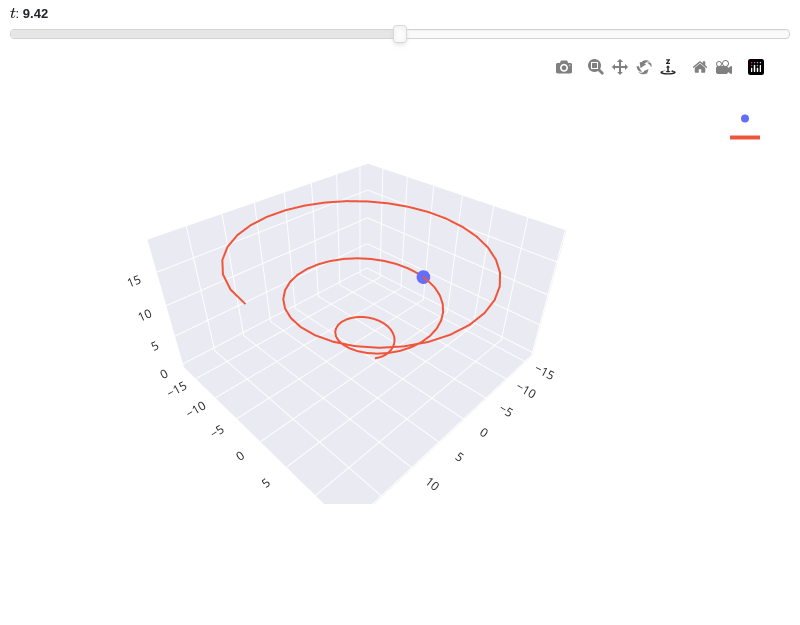3D general plotting
NOTE:
For technical reasons, all interactive-widgets plots in this documentation
are created using Holoviz’s Panel. Often, they will ran just fine with
ipywidgets too. However, if a specific example uses the param library,
or widgets from the panel module, then users will have to modify the
params dictionary in order to make it work with ipywidgets.
Refer to Interactive module for more information.
- spb.plot_functions.functions_3d.plot3d(*args, **kwargs)[source]
Plots a 3D surface plot.
Typical usage examples are in the followings:
Plotting a single expression:
plot3d(expr, range_x, range_y, **kwargs)
Plotting multiple expressions with the same ranges:
plot3d(expr1, expr2, range_x, range_y, **kwargs)
Plotting multiple expressions with different ranges, custom labels and rendering options:
plot3d( (expr1, range_x1, range_y1, label1 [opt], rendering_kw1 [opt]), (expr2, range_x2, range_y2, label2 [opt], rendering_kw2 [opt]), ..., **kwargs)
Note: it is important to specify at least the
range_x, otherwise the function might create a rotated plot.Refer to
surface()for a full list of keyword arguments to customize the appearances of surfaces.Refer to
graphics()for a full list of keyword arguments to customize the appearances of the figure (title, axis labels, …).- Parameters:
- labelstr or list/tuple, optional
The label to be shown in the legend. If not provided, the string representation of expr will be used. The number of labels must be equal to the number of expressions.
- rendering_kwdict or list of dicts, optional
A dictionary of keywords/values which is passed to the backend’s function to customize the appearance of lines. Refer to the plotting library (backend) manual for more informations. If a list of dictionaries is provided, the number of dictionaries must be equal to the number of expressions.
See also
plot3d_parametric_list,plot3d_parametric_surface,plot3d_sphericalplot3d_revolution,plot3d_implicit,plot3d_list,plot_contour
Examples
>>> from sympy import symbols, cos, sin, pi, exp >>> from spb import plot3d >>> x, y = symbols('x y')
Single plot with Matplotlib:
>>> plot3d(cos((x**2 + y**2)), (x, -3, 3), (y, -3, 3)) Plot object containing: [0]: cartesian surface: cos(x**2 + y**2) for x over (-3.0, 3.0) and y over (-3.0, 3.0)
(
Source code,png)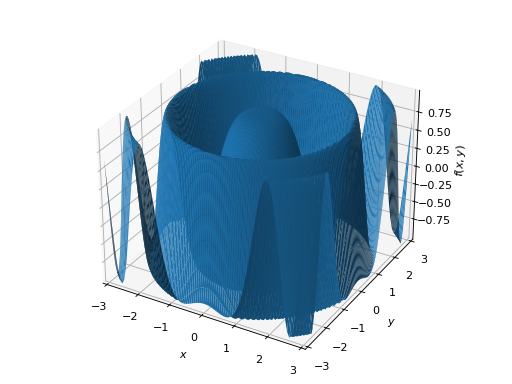
Single plot with Plotly, illustrating how to apply:
a color map: by default, it will map colors to the z values.
wireframe lines to better understand the discretization and curvature.
transformation to the discretized ranges in order to convert radians to degrees.
custom aspect ratio with Plotly.
from sympy import symbols, sin, cos, pi from spb import plot3d, PB import numpy as np x, y = symbols("x, y") expr = (cos(x) + sin(x) * sin(y) - sin(x) * cos(y))**2 plot3d( expr, (x, 0, pi), (y, 0, 2 * pi), backend=PB, use_cm=True, tx=np.rad2deg, ty=np.rad2deg, wireframe=True, wf_n1=20, wf_n2=20, xlabel="x [deg]", ylabel="y [deg]", aspect=dict(x=1.5, y=1.5, z=0.5))
(Source code, png)
Multiple plots with same range using color maps. By default, colors are mapped to the z values:
>>> plot3d(x*y, -x*y, (x, -5, 5), (y, -5, 5), use_cm=True) Plot object containing: [0]: cartesian surface: x*y for x over (-5.0, 5.0) and y over (-5.0, 5.0) [1]: cartesian surface: -x*y for x over (-5.0, 5.0) and y over (-5.0, 5.0)
(
Source code,png)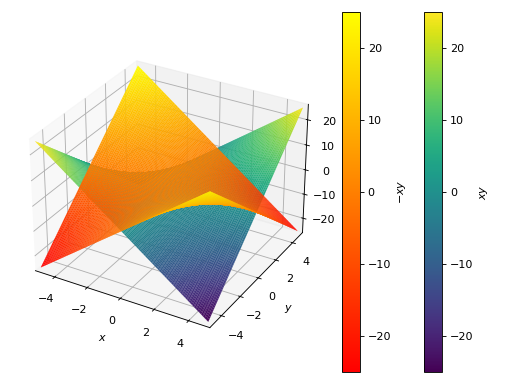
Multiple plots with different ranges and solid colors.
>>> f = x**2 + y**2 >>> plot3d((f, (x, -3, 3), (y, -3, 3)), ... (-f, (x, -5, 5), (y, -5, 5))) Plot object containing: [0]: cartesian surface: x**2 + y**2 for x over (-3.0, 3.0) and y over (-3.0, 3.0) [1]: cartesian surface: -x**2 - y**2 for x over (-5.0, 5.0) and y over (-5.0, 5.0)
(
Source code,png)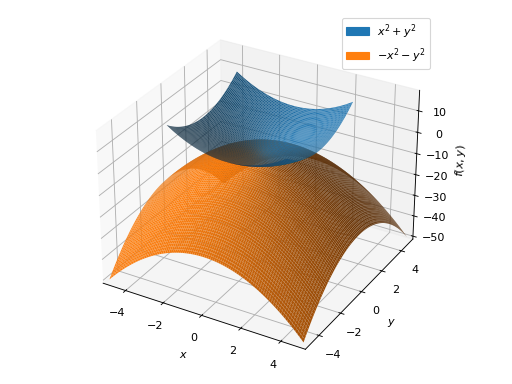
Single plot with a polar discretization, a color function mapping a colormap to the radius. Note that the same result can be achieved with
plot3d_revolution.from sympy import * from spb import * import numpy as np r, theta = symbols("r, theta") expr = cos(r**2) * exp(-r / 3) plot3d(expr, (r, 0, 5), (theta, 1.6 * pi, 2 * pi), backend=KB, is_polar=True, legend=True, grid=False, use_cm=True, color_func=lambda x, y, z: np.sqrt(x**2 + y**2), wireframe=True, wf_n1=30, wf_n2=10, wf_rendering_kw={"width": 0.005})
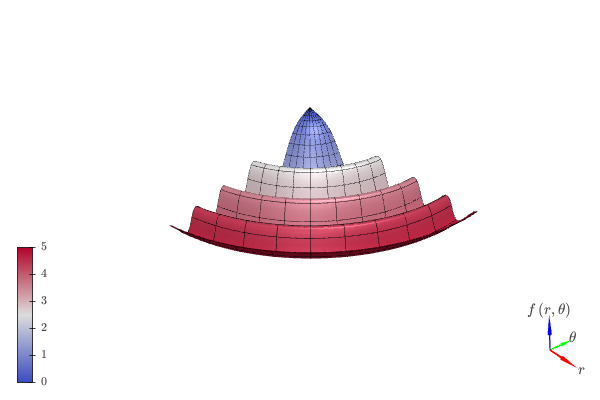
Plotting a numerical function instead of a symbolic expression:
>>> plot3d(lambda x, y: x * np.exp(-x**2 - y**2), ... ("x", -3, 3), ("y", -3, 3), use_cm=True)
(
Source code,png)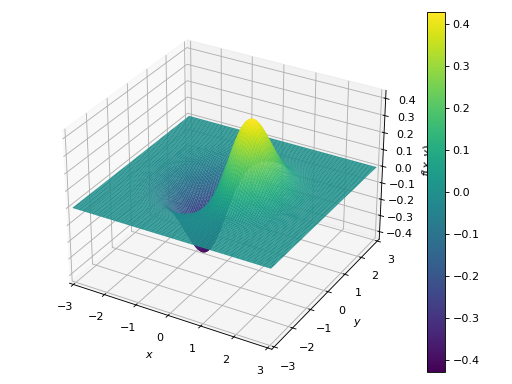
Interactive-widget plot. Refer to the interactive sub-module documentation to learn more about the
paramsdictionary. This plot illustrates:the use of
prange(parametric plotting range).the use of the
paramsdictionary to specify sliders in their basic form: (default, min, max).the use of
panel.widgets.slider.RangeSlider, which is a 2-values widget.
from sympy import * from spb import * import panel as pn x, y, a, b, c, d, e = symbols("x y a b c d e") plot3d( cos(x**2 + y**2) * exp(-(x**2 + y**2) * a), prange(x, b, c), prange(y, d, e), params={ a: (0.25, 0, 1), (b, c): pn.widgets.RangeSlider( value=(-2, 2), start=-4, end=4, step=0.1), (d, e): pn.widgets.RangeSlider( value=(-2, 2), start=-4, end=4, step=0.1), }, backend=PB, use_cm=True, n=100, aspect=dict(x=1.5, y=1.5, z=0.75), wireframe=True, wf_n1=15, wf_n2=15, throttled=True)
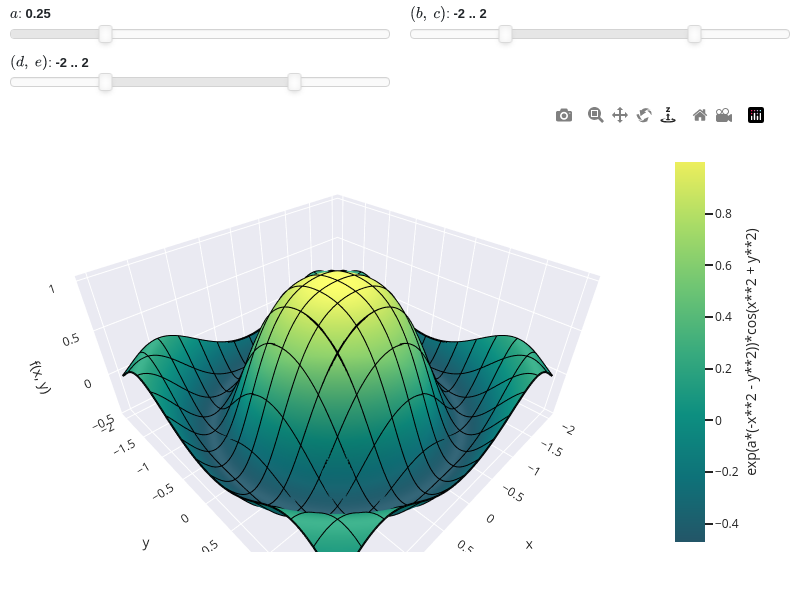
- spb.plot_functions.functions_3d.plot3d_parametric_line(*args, **kwargs)[source]
Plots a 3D parametric line plot.
Typical usage examples are in the followings:
Plotting a single expression:
plot3d_parametric_line(expr_x, expr_y, expr_z, range, **kwargs)
Plotting a single expression with a custom label and rendering options:
plot3d_parametric_line(expr_x, expr_y, expr_z, range, label [opt], rendering_kw [opt], **kwargs)
Plotting multiple expressions with the same ranges:
plot3d_parametric_line((expr_x1, expr_y1, expr_z1), (expr_x2, expr_y2, expr_z2), ..., range, **kwargs)
Plotting multiple expressions with different ranges, custom labels and rendering options:
plot3d_parametric_line( (expr_x1, expr_y1, expr_z1, range1, label1, rendering_kw1), (expr_x2, expr_y2, expr_z2, range2, label1, rendering_kw2), ..., **kwargs)
Refer to
line_parametric_3d()for a full list of keyword arguments to customize the appearances of lines.Refer to
graphics()for a full list of keyword arguments to customize the appearances of the figure (title, axis labels, …).See also
Examples
>>> from sympy import symbols, cos, sin, pi, root >>> from spb import plot3d_parametric_line >>> t = symbols('t')
Single plot.
>>> plot3d_parametric_line(cos(t), sin(t), t, (t, -5, 5)) Plot object containing: [0]: 3D parametric cartesian line: (cos(t), sin(t), t) for t over (-5.0, 5.0)
(
Source code,png)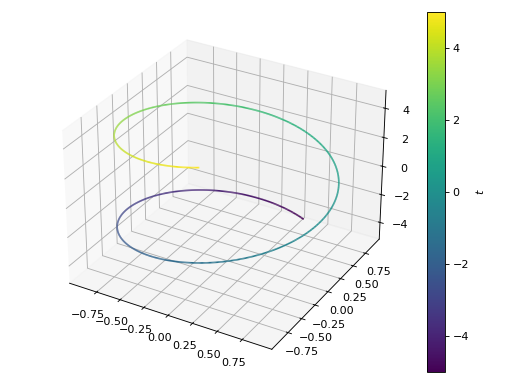
Customize the appearance by setting a label to the colorbar, changing the colormap and the line width.
>>> plot3d_parametric_line( ... 3 * sin(t) + 2 * sin(3 * t), cos(t) - 2 * cos(3 * t), cos(5 * t), ... (t, 0, 2 * pi), "t [rad]", {"cmap": "hsv", "lw": 1.5}, ... aspect="equal") Plot object containing: [0]: 3D parametric cartesian line: (3*sin(t) + 2*sin(3*t), cos(t) - 2*cos(3*t), cos(5*t)) for t over (0.0, 6.283185307179586)
(
Source code,png)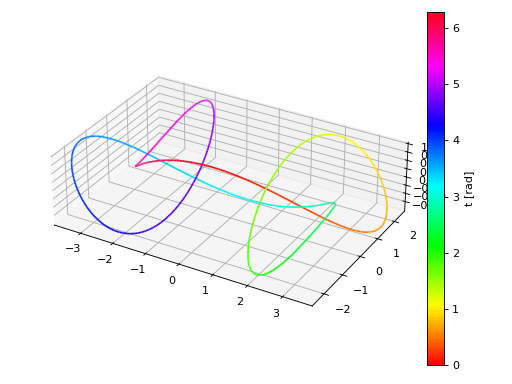
Plot multiple parametric 3D lines with different ranges:
>>> a, b, n = 2, 1, 4 >>> p, r, s = symbols("p r s") >>> xp = a * cos(p) * cos(n * p) >>> yp = a * sin(p) * cos(n * p) >>> zp = b * cos(n * p)**2 + pi >>> xr = root(r, 3) * cos(r) >>> yr = root(r, 3) * sin(r) >>> zr = 0 >>> plot3d_parametric_line( ... (xp, yp, zp, (p, 0, pi if n % 2 == 1 else 2 * pi), "petals"), ... (xr, yr, zr, (r, 0, 6*pi), "roots"), ... (-sin(s)/3, 0, s, (s, 0, pi), "stem"), use_cm=False) Plot object containing: [0]: 3D parametric cartesian line: (2*cos(p)*cos(4*p), 2*sin(p)*cos(4*p), cos(4*p)**2 + pi) for p over (0.0, 6.283185307179586) [1]: 3D parametric cartesian line: (r**(1/3)*cos(r), r**(1/3)*sin(r), 0) for r over (0.0, 18.84955592153876) [2]: 3D parametric cartesian line: (-sin(s)/3, 0, s) for s over (0.0, 3.141592653589793)
(
Source code,png)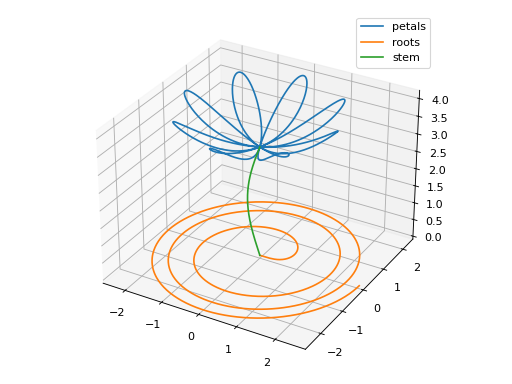
Plotting a numerical function instead of a symbolic expression, using Plotly:
from spb import plot3d_parametric_line, PB import numpy as np fx = lambda t: (1 + 0.25 * np.cos(75 * t)) * np.cos(t) fy = lambda t: (1 + 0.25 * np.cos(75 * t)) * np.sin(t) fz = lambda t: t + 2 * np.sin(75 * t) plot3d_parametric_line(fx, fy, fz, ("t", 0, 6 * np.pi), {"line": {"colorscale": "bluered"}}, title="Helical Toroid", backend=PB, adaptive=False, n=1e04)
(Source code, png)
Interactive-widget plot of the parametric line over a tennis ball. Refer to the interactive sub-module documentation to learn more about the
paramsdictionary. This plot illustrates:combining together different plots.
the use of
prange(parametric plotting range).the use of the
paramsdictionary to specify sliders in their basic form: (default, min, max).
from sympy import * from spb import * import k3d a, b, s, e, t = symbols("a, b, s, e, t") c = 2 * sqrt(a * b) r = a + b params = { a: (1.5, 0, 2), b: (1, 0, 2), s: (0, 0, 2), e: (2, 0, 2) } sphere = plot3d_revolution( (r * cos(t), r * sin(t)), (t, 0, pi), params=params, n=50, parallel_axis="x", backend=KB, show_curve=False, show=False, rendering_kw={"color":0x353535}) line = plot3d_parametric_line( a * cos(t) + b * cos(3 * t), a * sin(t) - b * sin(3 * t), c * sin(2 * t), prange(t, s*pi, e*pi), {"color_map": k3d.matplotlib_color_maps.Summer}, params=params, backend=KB, show=False) (line + sphere).show()
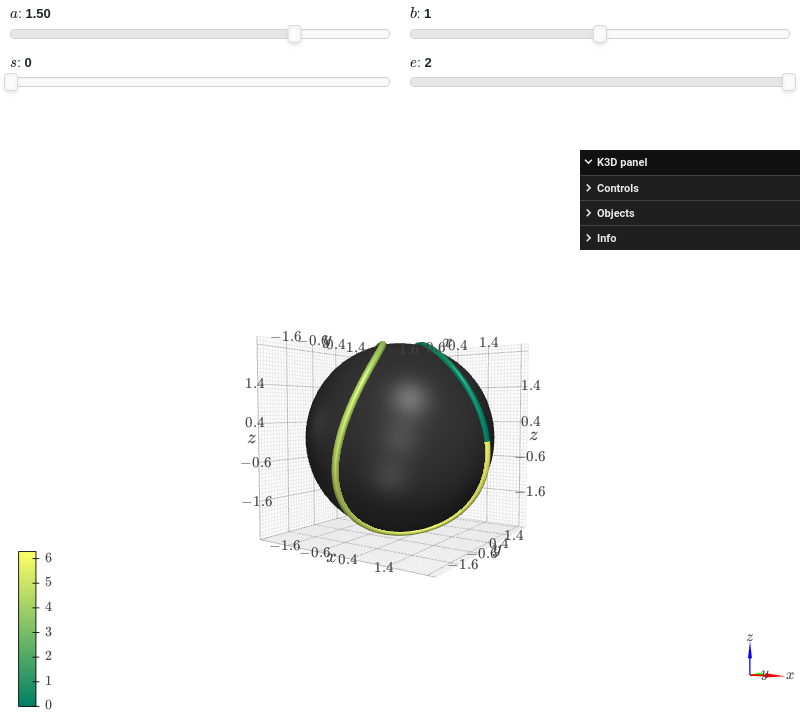
- spb.plot_functions.functions_3d.plot3d_parametric_surface(*args, **kwargs)[source]
Plots a 3D parametric surface plot.
Typical usage examples are in the followings:
Plotting a single expression:
plot3d_parametric_surface( expr_x, expr_y, expr_z, range_u, range_v, label, **kwargs)
Plotting multiple expressions with the same ranges:
plot3d_parametric_surface((expr_x1, expr_y1, expr_z1), (expr_x2, expr_y2, expr_z2), range_u, range_v, **kwargs)
Plotting multiple expressions with different ranges, custom labels and rendering option:
plot3d_parametric_surface( (expr_x1, expr_y1, expr_z1, range_u1, range_v1, label1 [opt], rendering_kw1 [opt]), (expr_x2, expr_y2, expr_z2, range_u2, range_v2, label2 [opt], rendering_kw2 [opt]), **kwargs)`
Note: it is important to specify both the ranges.
Refer to
surface_parametric()for a full list of keyword arguments to customize the appearances of surfaces.Refer to
graphics()for a full list of keyword arguments to customize the appearances of the figure (title, axis labels, …).- Parameters:
- labelstr or list/tuple, optional
The label to be shown in the legend. If not provided, the string representation of expr will be used. The number of labels must be equal to the number of expressions.
- rendering_kwdict or list of dicts, optional
A dictionary of keywords/values which is passed to the backend’s function to customize the appearance of lines. Refer to the plotting library (backend) manual for more informations. If a list of dictionaries is provided, the number of dictionaries must be equal to the number of expressions.
See also
plot3d,plot3d_parametric_list,plot3d_sphericalplot3d_revolution,plot3d_implicit,plot3d_list
Examples
>>> from sympy import symbols, cos, sin, pi, I, sqrt, atan2, re, im >>> from spb import plot3d_parametric_surface >>> u, v = symbols('u v')
Plot a parametric surface:
>>> plot3d_parametric_surface( ... u * cos(v), u * sin(v), u * cos(4 * v) / 2, ... (u, 0, pi), (v, 0, 2*pi), ... use_cm=False, title="Sinusoidal Cone") Plot object containing: [0]: parametric cartesian surface: (u*cos(v), u*sin(v), u*cos(4*v)/2) for u over (0.0, 3.141592653589793) and v over (0.0, 6.283185307179586)
(
Source code,png)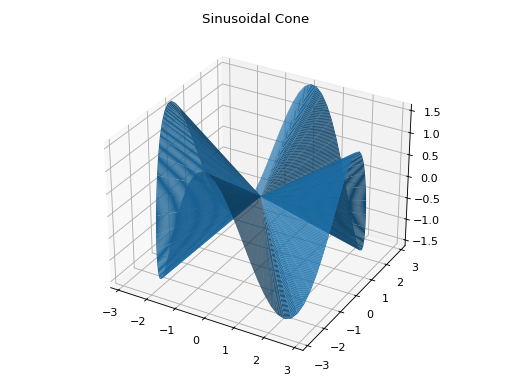
Customize the appearance of the surface by changing the colormap. Apply a color function mapping the v values. Activate the wireframe to better visualize the parameterization.
from sympy import * from spb import * import k3d var("u, v") x = (1 + v / 2 * cos(u / 2)) * cos(u) y = (1 + v / 2 * cos(u / 2)) * sin(u) z = v / 2 * sin(u / 2) plot3d_parametric_surface( x, y, z, (u, 0, 2*pi), (v, -1, 1), "v", {"color_map": k3d.colormaps.paraview_color_maps.Hue_L60}, backend=KB, use_cm=True, color_func=lambda u, v: u, title=r"Möbius \, strip", wireframe=True, wf_n1=20, wf_rendering_kw={"width": 0.004})
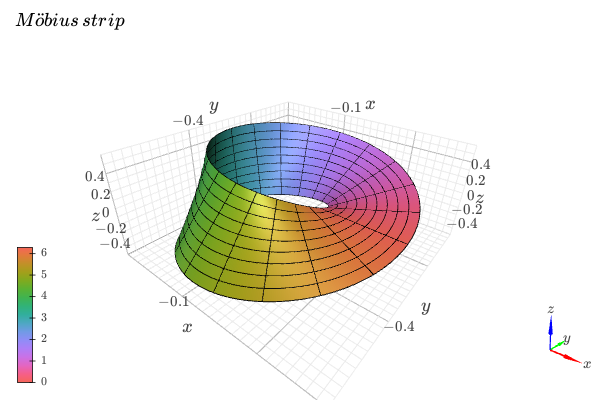
Riemann surfaces of the real part of the multivalued function z**n, using Plotly:
from sympy import symbols, sqrt, re, im, pi, atan2, sin, cos, I from spb import plot3d_parametric_surface, PB r, theta, x, y = symbols("r, theta, x, y", real=True) mag = lambda z: sqrt(re(z)**2 + im(z)**2) phase = lambda z, k=0: atan2(im(z), re(z)) + 2 * k * pi n = 2 # exponent (integer) z = x + I * y # cartesian d = {x: r * cos(theta), y: r * sin(theta)} # cartesian to polar branches = [(mag(z)**(1 / n) * cos(phase(z, i) / n)).subs(d) for i in range(n)] exprs = [(r * cos(theta), r * sin(theta), rb) for rb in branches] plot3d_parametric_surface(*exprs, (r, 0, 3), (theta, -pi, pi), backend=PB, wireframe=True, wf_n2=20, zlabel="f(z)", label=["branch %s" % (i + 1) for i in range(len(branches))])
(Source code, png)
Plotting a numerical function instead of a symbolic expression.
from spb import * import numpy as np fx = lambda u, v: (4 + np.cos(u)) * np.cos(v) fy = lambda u, v: (4 + np.cos(u)) * np.sin(v) fz = lambda u, v: np.sin(u) plot3d_parametric_surface(fx, fy, fz, ("u", 0, 2 * np.pi), ("v", 0, 2 * np.pi), zlim=(-2.5, 2.5), title="Torus", backend=KB, grid=False)
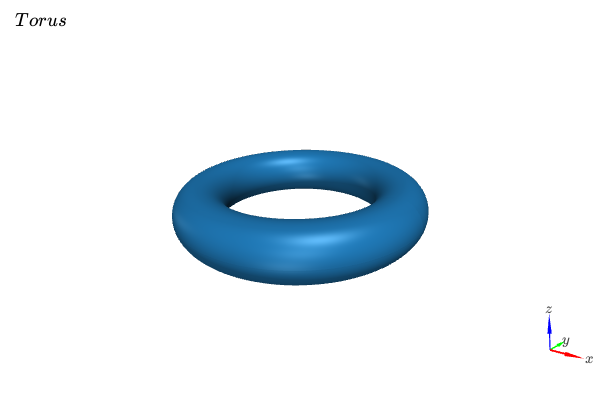
Interactive-widget plot. Refer to the interactive sub-module documentation to learn more about the
paramsdictionary. This plot illustrates:the use of
prange(parametric plotting range).the use of the
paramsdictionary to specify sliders in their basic form: (default, min, max).
from sympy import * from spb import * import k3d alpha, u, v, up, vp = symbols("alpha u v u_p v_p") plot3d_parametric_surface(( exp(u) * cos(v - alpha) / 2 + exp(-u) * cos(v + alpha) / 2, exp(u) * sin(v - alpha) / 2 + exp(-u) * sin(v + alpha) / 2, cos(alpha) * u + sin(alpha) * v ), prange(u, -up, up), prange(v, 0, vp * pi), backend=KB, use_cm=True, color_func=lambda u, v: v, rendering_kw={"color_map": k3d.colormaps.paraview_color_maps.Hue_L60}, wireframe=True, wf_n2=15, wf_rendering_kw={"width": 0.005}, grid=False, n=50, params={ alpha: (0, 0, pi), up: (1, 0, 2), vp: (2, 0, 2), }, title=r"Catenoid \, to \, Right \, Helicoid \, Transformation")
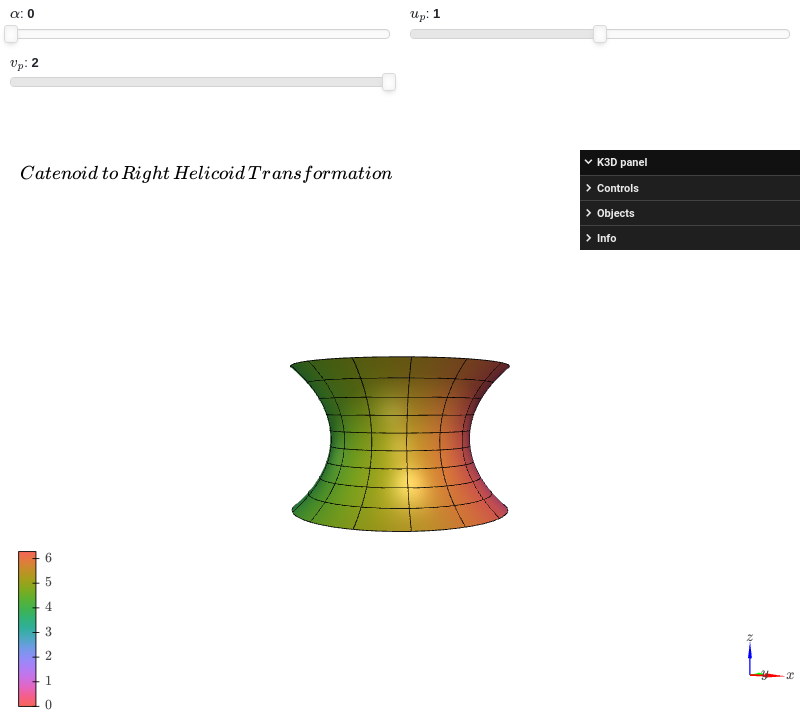
Interactive-widget plot. Refer to the interactive sub-module documentation to learn more about the
paramsdictionary. Note that the plot’s creation might be slow due to the wireframe lines.from sympy import * from spb import * import panel as pn n, u, v = symbols("n, u, v") x = v * cos(u) y = v * sin(u) z = sin(n * u) plot3d_parametric_surface( (x, y, z, (u, 0, 2*pi), (v, -1, 0)), params = { n: pn.widgets.IntInput(value=3, name="n") }, backend=KB, use_cm=True, title=r"Plücker's \, conoid", wireframe=True, wf_rendering_kw={"width": 0.004}, wf_n1=75, wf_n2=6, imodule="panel" )
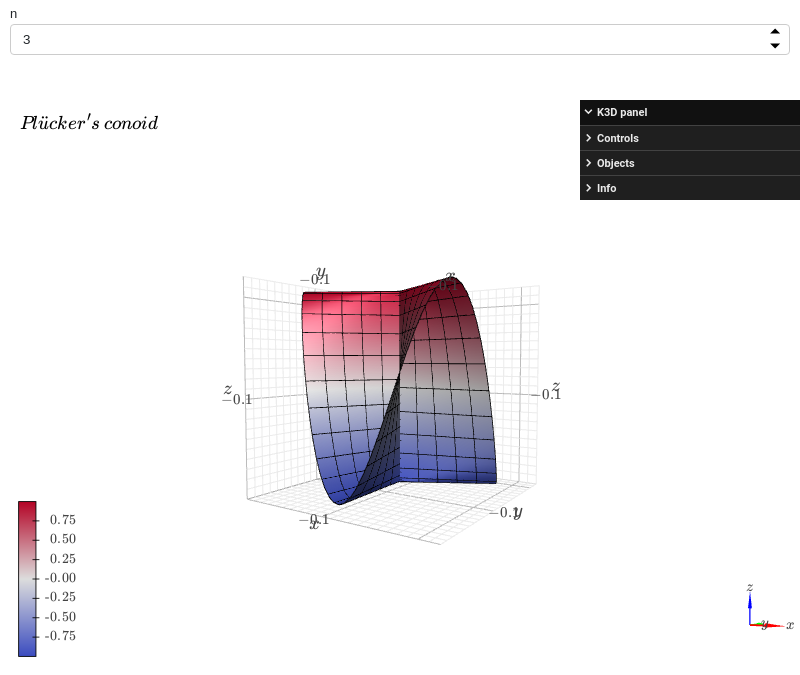
- spb.plot_functions.functions_3d.plot3d_spherical(*args, **kwargs)[source]
Plots a radius as a function of the spherical coordinates theta and phi.
Typical usage examples are in the followings:
Plotting a single expression.:
plot3d_spherical(r, range_theta, range_phi, **kwargs)
Plotting multiple expressions with the same ranges.:
plot3d_spherical(r1, r2, range_theta, range_phi, **kwargs)
Plotting multiple expressions with different ranges, custom labels and rendering options:
plot3d_spherical( (r1, range_theta1, range_phi1, label1 [opt], rendering_kw1 [opt]), (r2, range_theta2, range_phi2, label2 [opt], rendering_kw2 [opt]), ..., **kwargs)
Note: it is important to specify both the ranges.
Refer to
surface_spherical()for a full list of keyword arguments to customize the appearances of surfaces.Refer to
graphics()for a full list of keyword arguments to customize the appearances of the figure (title, axis labels, …).- Parameters:
- labelstr or list/tuple, optional
The label to be shown in the legend. If not provided, the string representation of expr will be used. The number of labels must be equal to the number of expressions.
- rendering_kwdict or list of dicts, optional
A dictionary of keywords/values which is passed to the backend’s function to customize the appearance of lines. Refer to the plotting library (backend) manual for more informations. If a list of dictionaries is provided, the number of dictionaries must be equal to the number of expressions.
See also
plot3d,plot3d_parametric_list,plot3d_parametric_surfaceplot3d_revolution,plot3d_implicit,plot3d_list
Examples
>>> from sympy import symbols, cos, sin, pi, Ynm, re, lambdify >>> from spb import plot3d_spherical >>> theta, phi = symbols('theta phi')
Sphere cap:
>>> plot3d_spherical(1, (theta, 0, 0.7 * pi), (phi, 0, 1.8 * pi)) Plot object containing: [0]: parametric cartesian surface: (sin(theta)*cos(phi), sin(phi)*sin(theta), cos(theta)) for theta over (0.0, 2.199114857512855) and phi over (0.0, 5.654866776461628)
(
Source code,png)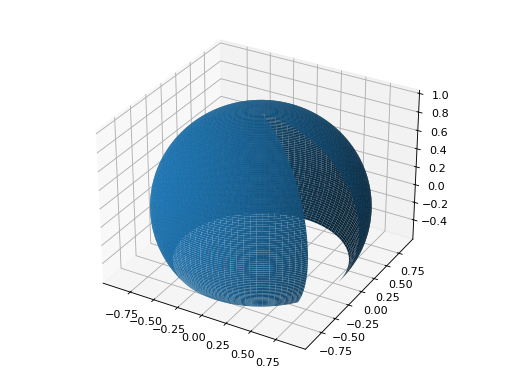
Plot real spherical harmonics, highlighting the regions in which the real part is positive and negative, using Plotly:
from sympy import symbols, sin, pi, Ynm, re, lambdify from spb import plot3d_spherical, PB theta, phi = symbols('theta phi') r = re(Ynm(3, 3, theta, phi).expand(func=True).rewrite(sin).expand()) plot3d_spherical( abs(r), (theta, 0, pi), (phi, 0, 2 * pi), "radius", use_cm=True, n2=200, backend=PB, color_func=lambdify([theta, phi], r))
(Source code, png)
Multiple surfaces with wireframe lines, using Plotly. Note that activating the wireframe option might add a considerable overhead during the plot’s creation.
from sympy import symbols, sin, pi from spb import plot3d_spherical, PB theta, phi = symbols('theta phi') r1 = 1 r2 = 1.5 + sin(5 * phi) * sin(10 * theta) / 10 plot3d_spherical(r1, r2, (theta, 0, pi / 2), (phi, 0.35 * pi, 2 * pi), wireframe=True, wf_n2=25, backend=PB, label=["r1", "r2"])
(Source code, png)
Interactive-widget plot of real spherical harmonics, highlighting the regions in which the real part is positive and negative. Note that the plot’s creation and update might be slow and that it must be
m < nat all times. Refer to the interactive sub-module documentation to learn more about theparamsdictionary.from sympy import * from spb import * import panel as pn n, m = symbols("n, m") phi, theta = symbols("phi, theta", real=True) r = re(Ynm(n, m, theta, phi).expand(func=True).rewrite(sin).expand()) plot3d_spherical( abs(r), (theta, 0, pi), (phi, 0, 2*pi), params = { n: pn.widgets.IntInput(value=2, name="n"), m: pn.widgets.IntInput(value=0, name="m"), }, force_real_eval=True, use_cm=True, color_func=r, backend=KB, imodule="panel")
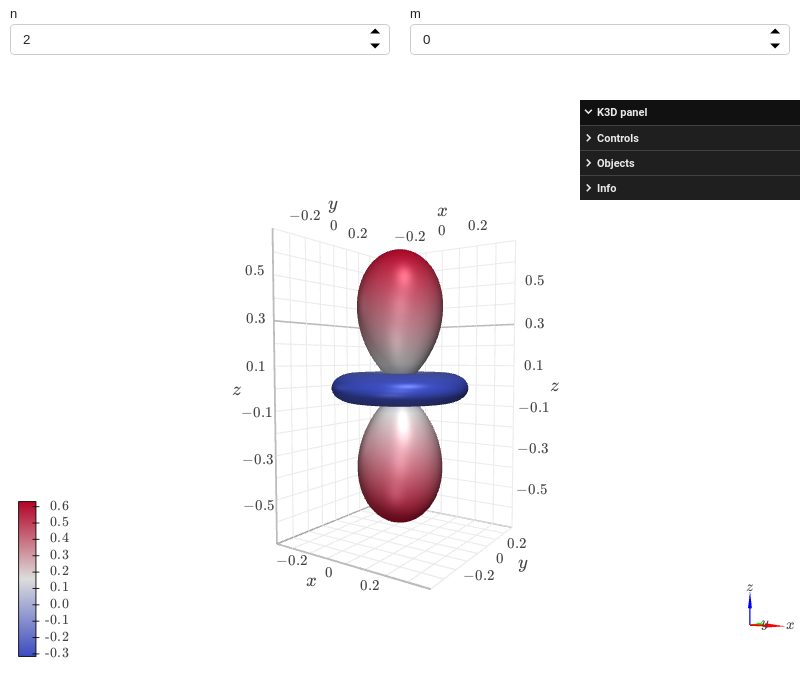
- spb.plot_functions.functions_3d.plot3d_revolution(curve, range_t, range_phi=None, axis=(0, 0), parallel_axis='z', show_curve=False, curve_kw={}, **kwargs)[source]
Generate a surface of revolution by rotating a curve around an axis of rotation.
Refer to
surface_revolution()for a full list of keyword arguments to customize the appearances of surfaces.Refer to
graphics()for a full list of keyword arguments to customize the appearances of the figure (title, axis labels, …).- Parameters:
- labelstr or list/tuple, optional
The label to be shown in the legend. If not provided, the string representation of expr will be used. The number of labels must be equal to the number of expressions.
- rendering_kwdict or list of dicts, optional
A dictionary of keywords/values which is passed to the backend’s function to customize the appearance of lines. Refer to the plotting library (backend) manual for more informations. If a list of dictionaries is provided, the number of dictionaries must be equal to the number of expressions.
See also
plot3d,plot3d_parametric_list,plot3d_parametric_surfaceplot3d_spherical,plot3d_implicit,plot3d_list
Examples
>>> from sympy import symbols, cos, sin, pi >>> from spb import plot3d_revolution >>> t, phi = symbols('t phi')
Revolve a function around the z axis:
>>> plot3d_revolution( ... cos(t), (t, 0, pi), ... # use a color map on the surface to indicate the azimuthal angle ... use_cm=True, color_func=lambda t, phi: phi, ... rendering_kw={"alpha": 0.6, "cmap": "twilight"}, ... # indicates the azimuthal angle on the colorbar label ... label=r"$\phi$ [rad]", ... show_curve=True, ... # this dictionary will be passes to plot3d_parametric_line in ... # order to draw the initial curve ... curve_kw=dict(rendering_kw={"color": "r", "label": "cos(t)"}), ... # activate the wireframe to visualize the parameterization ... wireframe=True, wf_n1=15, wf_n2=15, ... wf_rendering_kw={"lw": 0.5, "alpha": 0.75})
(
Source code,png)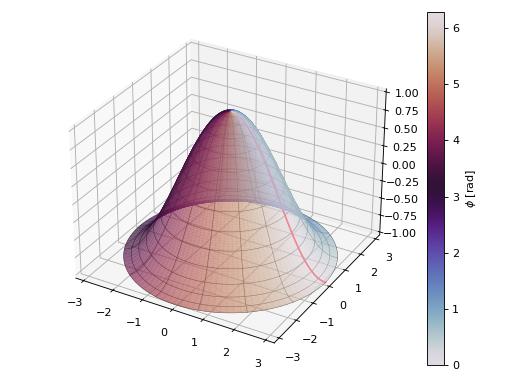
Revolve the same function around an axis parallel to the x axis, using Plotly:
from sympy import symbols, cos, sin, pi from spb import plot3d_revolution, PB t, phi = symbols('t phi') plot3d_revolution( cos(t), (t, 0, pi), parallel_axis="x", axis=(1, 0), backend=PB, use_cm=True, color_func=lambda t, phi: phi, rendering_kw={"colorscale": "twilight"}, label="phi [rad]", show_curve=True, curve_kw=dict(rendering_kw={"line": {"color": "red", "width": 8}, "name": "cos(t)"}), wireframe=True, wf_n1=15, wf_n2=15, wf_rendering_kw={"line_width": 1})
(Source code, png)
Revolve a 2D parametric circle around the z axis:
from sympy import * from spb import * t = symbols("t") circle = (3 + cos(t), sin(t)) plot3d_revolution(circle, (t, 0, 2 * pi), backend=KB, show_curve=True, rendering_kw={"opacity": 0.65}, curve_kw={"rendering_kw": {"width": 0.05}})
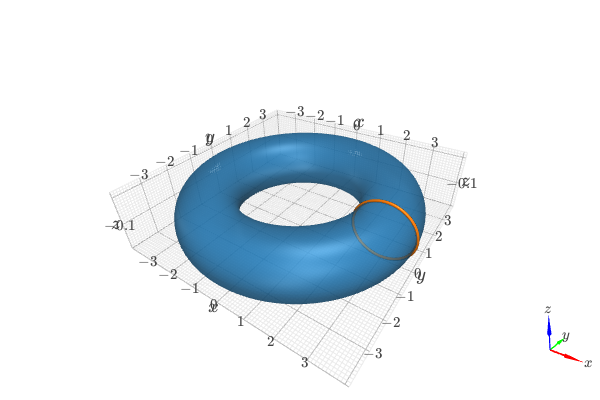
Revolve a 3D parametric curve around the z axis for a given azimuthal angle, using Plotly:
plot3d_revolution( (cos(t), sin(t), t), (t, 0, 2*pi), (phi, 0, pi), use_cm=True, color_func=lambda t, phi: t, label="t [rad]", show_curve=True, backend=PB, aspect="cube", wireframe=True, wf_n1=2, wf_n2=5)
(Source code, png)
Interactive-widget plot of a goblet. Refer to the interactive sub-module documentation to learn more about the
paramsdictionary. This plot illustrates:the use of
prange(parametric plotting range).the use of the
paramsdictionary to specify sliders in their basic form: (default, min, max).
from sympy import * from spb import * t, phi, u, v, w = symbols("t phi u v w") plot3d_revolution( (t, cos(u * t), t**2), prange(t, 0, v), prange(phi, 0, w*pi), axis=(1, 0.2), params={ u: (2.5, 0, 6), v: (2, 0, 3), w: (2, 0, 2) }, n=50, backend=KB, force_real_eval=True, wireframe=True, wf_n1=15, wf_n2=15, wf_rendering_kw={"width": 0.004}, show_curve=True, curve_kw={"rendering_kw": {"width": 0.025}})
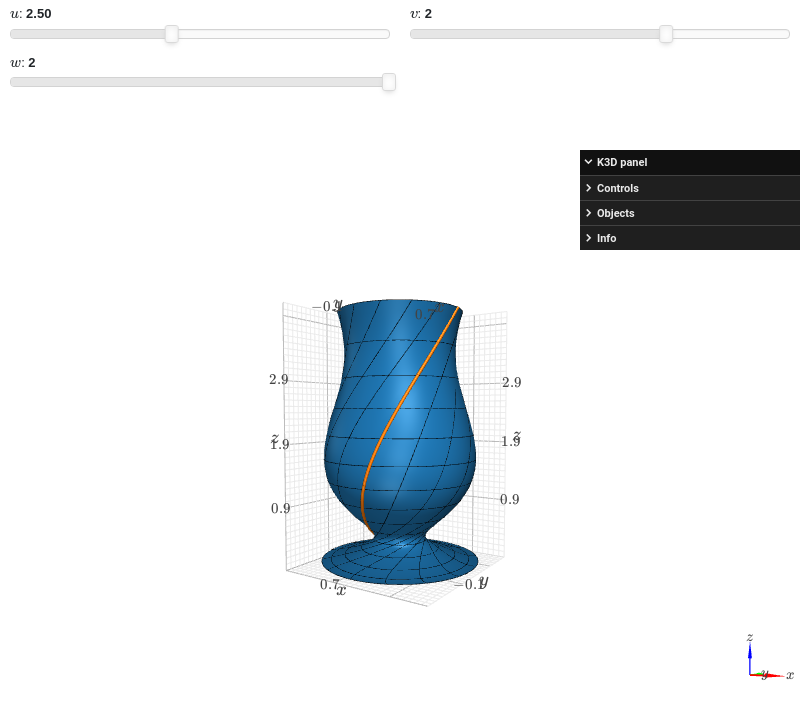
- spb.plot_functions.functions_3d.plot3d_implicit(*args, **kwargs)[source]
Plots an isosurface of a function.
Typical usage examples are in the followings:
Plotting a single expression:
plot3d_implicit( expr, range_x, range_y, range_z, rendering_kw [optional], **kwargs)
Plotting a multiple expression over the same range:
plot3d_implicit( expr1, expr2, range_x, range_y, range_z, rendering_kw [optional], **kwargs)`
Plotting a multiple expression with different range and rendering options:
plot3d_implicit( (expr1, range_x1, range_y1, range_z1, rendering_kw1 [opt]), (expr2, range_x2, range_y2, range_z2, rendering_kw2 [opt]), **kwargs)`
Refer to
implicit_3d()for a full list of keyword arguments to customize the appearances of surfaces.Refer to
graphics()for a full list of keyword arguments to customize the appearances of the figure (title, axis labels, …).See also
plot3d,plot3d_parametric_list,plot3d_parametric_surfaceplot3d_spherical,plot3d_revolution,plot3d_list
Notes
the number of discretization points is crucial as the algorithm will discretize a volume. A high number of discretization points creates a smoother mesh, at the cost of a much higher memory consumption and slower computation.
Only
PlotlyBackendandK3DBackendsupport 3D implicit plotting.To plot
f(x, y, z) = ceither writeexpr = f(x, y, z) - cor pass the appropriate keyword torendering_kw. Read the backends documentation to find out the available options.
Examples
from sympy import symbols from spb import plot3d_implicit, PB, KB x, y, z = symbols('x, y, z') plot3d_implicit( x**2 + y**3 - z**2, (x, -2, 2), (y, -2, 2), (z, -2, 2), backend=PB)
(Source code, png)
plot3d_implicit( x**4 + y**4 + z**4 - (x**2 + y**2 + z**2 - 0.3), (x, -2, 2), (y, -2, 2), (z, -2, 2), backend=PB)
(Source code, png)
Visualize the isocontours from isomin=0 to isomax=2 by providing a
rendering_kwdictionary:plot3d_implicit( 1/x**2 - 1/y**2 + 1/z**2, (x, -2, 2), (y, -2, 2), (z, -2, 2), { "isomin": 0, "isomax": 2, "colorscale":"aggrnyl", "showscale":True }, backend=PB )
(Source code, png)
- spb.plot_functions.functions_3d.plot3d_list(*args, **kwargs)[source]
Plots lists of coordinates (ie, lists of numbers) in 3D space.
Typical usage examples are in the followings:
Plotting coordinates of a single function:
plot3d_list(x, y, **kwargs)
Plotting coordinates of multiple functions, adding custom labels and rendering options:
plot3d_list( (x1, y1, z1, label1 [opt], rendering_kw1 [opt]), (x2, y2, z1, label2 [opt], rendering_kw2 [opt]), ..., **kwargs)
Refer to
list_3d()for a full list of keyword arguments to customize the appearances of lines.Refer to
graphics()for a full list of keyword arguments to customize the appearances of the figure (title, axis labels, …).See also
plot3d,plot3d_parametric_list,plot3d_parametric_surfaceplot3d_spherical,plot3d_revolution,plot3d_implicit
Examples
>>> from sympy import * >>> from spb import plot3d_list >>> import numpy as np
Plot the coordinates of a single function:
>>> z = np.linspace(0, 6*np.pi, 100) >>> x = z * np.cos(z) >>> y = z * np.sin(z) >>> plot3d_list(x, y, z) Plot object containing: [0]: 3D list plot
(
Source code,png)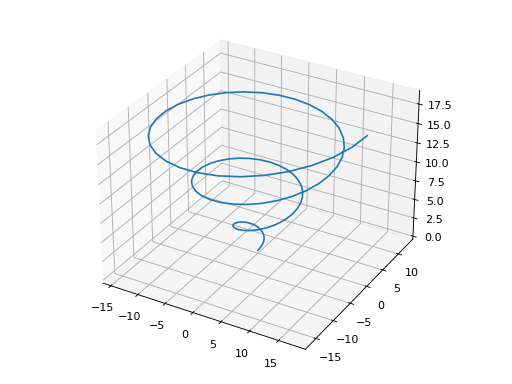
Plotting multiple functions with custom rendering keywords:
>>> plot3d_list( ... (x, y, z, "A"), ... (x, y, -z, "B", {"linestyle": "--"})) Plot object containing: [0]: 3D list plot [1]: 3D list plot
(
Source code,png)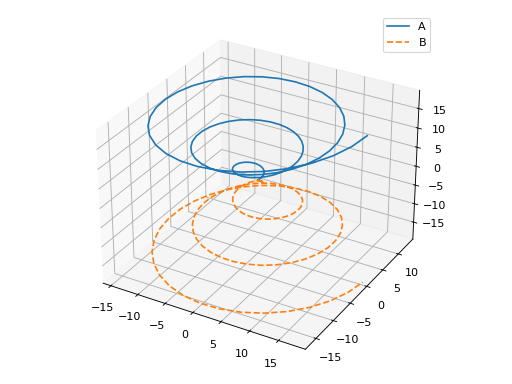
Interactive-widget plot of a dot following a path. Refer to the interactive sub-module documentation to learn more about the
paramsdictionary.from sympy import * from spb import * import numpy as np t = symbols("t") z = np.linspace(0, 6*np.pi, 100) x = z * np.cos(z) y = z * np.sin(z) p1 = plot3d_list(x, y, z, show=False, scatter=False) p2 = plot3d_list( [t * cos(t)], [t * sin(t)], [t], params={t: (3*pi, 0, 6*pi)}, backend=PB, show=False, scatter=True, imodule="panel") (p2 + p1).show()
